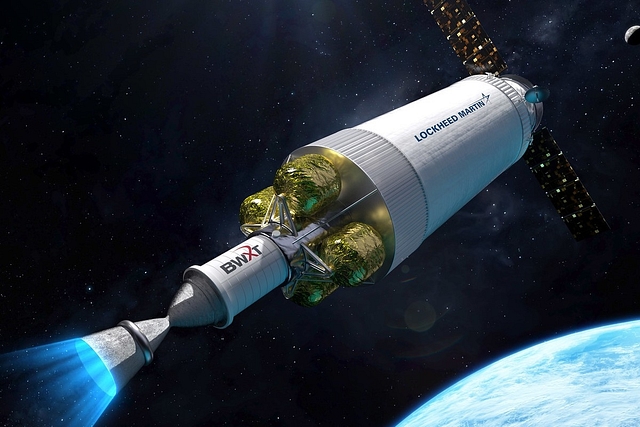Science
Next-Gen Rocket Propulsion Tech: NASA Selects Lockheed Martin To Develop Nuclear-Powered Spacecraft

An illustration of Nuclear-powered spacecraft
NASA and the US Defense Advanced Research Projects Agency (DARPA) Colorado-based Lockheed Martin Space as the prime contractor for the design, build, and testing of NASA and DARPA’s nuclear-powered rocket demonstration, in collaboration with other industry partners.
The Demonstration Rocket for Agile Cislunar Operations (DRACO) programme will test a nuclear-powered rocket in space as soon as 2027.
Chemical propulsion engines have long been the standard for spaceflight, but for humans to travel to Mars, they will need much more powerful and efficient propulsion.
Nuclear thermal propulsion (NTP) engines offer thrust as high as conventional chemical propulsion with two-to-five times higher efficiency, which means the spacecraft can travel faster and farther and can significantly reduce propellant needs.
They also enable abort scenarios on journeys to Mars that are not possible with chemical propulsion systems.
Earlier in January this year, NASA and the DARPA announced a collaboration to demonstrate a nuclear thermal rocket engine in space, an enabling capability for US space agency's crewed missions to Mars.
"Working with DARPA and companies across the commercial space industry will enable us to accelerate the technology development we need to send humans to Mars," NASA Deputy Administrator Pam Melroy said in a statement on Wednesday (26 July).
"This demonstration will be a crucial step in meeting our Moon to Mars objectives for crew transportation into deep space," Melroy added.
"A nuclear-powered rocket would allow for a shorter, faster trip to the Red Planet, reducing the mission's complexity and risk for the crew. This type of rocket can be more than twice as efficient as conventional chemical rockets, meaning it requires significantly less propellant and could carry more equipment for scientific goals. A nuclear-powered rocket also could provide more power for instruments and communications systems," NASA said.
Under the terms of its agreement with DARPA, Lockheed Martin is responsible for spacecraft design, integration, and testing.
BWX Technologies, based in Lynchburg, Virginia, will be responsible for the design and build of the nuclear fission reactor that will power the engine.
Further, NASA's Space Technology Mission Directorate (STMD) will be responsible for the overall management and execution of the nuclear-powered DRACO engine.
“Through NASA’s prior investments – in collaboration with the Department of Energy – we’ve supported the commercial sector to grow their capabilities in nuclear propulsion technology,” said Prasun Desai, acting associate administrator for STMD at NASA Headquarters in Washington.
“Now, those investments are coming full circle as we work with these same companies to build the first nuclear-powered rocket to fly in space," Desai added.
An Nuclear Thermal Propulsion system uses a nuclear reactor to quickly heat hydrogen propellant to very high temperatures and then funnels that gas through the engine nozzle to create powerful thrust.
The fission-based reactor will use a special high-assay low-enriched uranium (HALEU) to convert the cryogenic hydrogen into an extremely hot pressurised gas.
The reactor will not be turned on until the spacecraft has reached a nuclear safe orbit, making the NTP system very safe.
Support Swarajya's 50 Ground Reports Project & Sponsor A Story
Every general election Swarajya does a 50 ground reports project.
Aimed only at serious readers and those who appreciate the nuances of political undercurrents, the project provides a sense of India's electoral landscape. As you know, these reports are produced after considerable investment of travel, time and effort on the ground.
This time too we've kicked off the project in style and have covered over 30 constituencies already. If you're someone who appreciates such work and have enjoyed our coverage please consider sponsoring a ground report for just Rs 2999 to Rs 19,999 - it goes a long way in helping us produce more quality reportage.
You can also back this project by becoming a subscriber for as little as Rs 999 - so do click on this links and choose a plan that suits you and back us.
Click below to contribute.
Latest